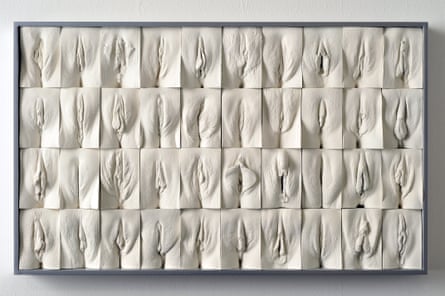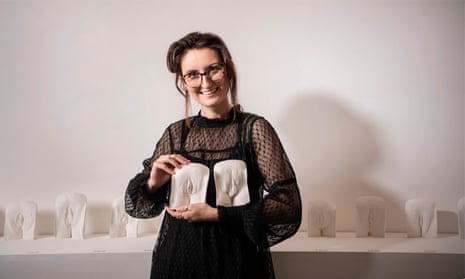When Florence Schechter opened the Vagina Museum – the world’s first museum dedicated to gynaecological anatomy – in London in 2019, it was partly a response to a dramatic rise in labiaplasty surgery. Instances of such surgery more than doubled in the first decade of this century, then carried on climbing. Zoe Williams, the spokesperson for the museum (who shares my name), says part of the problem is that most women have not seen other vulvas. “Quite a lot of people have never even seen their own, so it’s hard to have a concept of what’s normal. Certainly, throughout art history, the pictures of nude women very seldom had any protruding labia; you just had a neat little cleft.”
Labiaplasty is surgery to alter the appearance of the vulva – generally by trying to reduce the size of the labia minora, the inner genital lips, so that they don’t hang below the labia majora, the outer ones. The reasons for such surgery are not solely cosmetic – they could be related to childbirth, or chafing during sport – yet the rise is staggering. The number of labiaplasty surgeries in 2016 was up 45% on 2015 – the biggest growth of any cosmetic surgery procedure, according to the International Society of Aesthetic Plastic Surgery.
Now, however, a nascent movement is fighting back. It is rejecting the whole idea of genital perfection and reclaiming difference as part of being human – or, for brevity, celebrating what is becoming known on social media as an “outie labia”.
This is most noticeable on TikTok, where Ying Lee (@sativaplath69), who is 24 and uses the pronouns they/them, got a huge number of hits on a post about their “phat coochie” (phat means fat; coochie means vulva), then more still (6.4m) for a witty and complicated piece to camera about “gatekeeping phat coochie culture”.
“When I was making that post, there was a trend of talking about big, juicy coochies,” says Lee over the phone from Vancouver. “And you could apply this to any body part. There was a time when it wasn’t ideal to have big thighs or have a big ass – and then it suddenly was. I guess I get frustrated that women’s bodies are only acceptable when they’re on trend. A trend can normalise you – but only for as long as that’s the trend. And whether you’re in trend or not, you’re still going to have this body.”
Another TikToker, Jennifer Prentice (@jenniferprentice), makes the point deftly that, if you start a conversation about labia with anyone whose labia protrude, “it is like fireworks go off in their brain … I’m not weird? I’m not ugly?” Elsewhere on the site, sincere, social-savvy gynaecologists – such as Jennifer Lincoln (@drjenniferlincoln) and Jen Gunter (@drjengunter), the author of The Vagina Bible – explain the vast spectrum of what is normal, while campaigners share labiaplasty horror stories and myriad women turn the full beam of their scathing humour on a world that doesn’t understand how varied vulvas can be.
It is a movement that is sorely needed. In a poll of more than 3,600 readers, the online women’s magazine Refinery29 found that almost half (48%) had concerns about the appearance of their vulva. Of those, 64% were worried about the size and 60% about the shape of their vulva, with almost one-third (30%) worried about the colour of their genitals. But what is driving this shame and disgust that has become so profound that women have been moved to correct it surgically – and could this bold generation Z labia liberation front overturn it all?
Cabby Laffy, the founder and director of the Centre for Psychosexual Health in London, says it is not a new problem; it is one the late feminist sex researcher Shere Hite pointed out years ago. “Little girls look down at their genitals and they’re told they don’t have them: boys’ are outside, girls’ inside,” says Laffy. This is reflected in confusion around the language of female pudenda at the most basic level – many people say “vagina” when they mean “vulva”. “We don’t name the external genitals,” Laffy continues. “That non-naming is part of the shame, part of the disgust.”

The psychotherapist Julia Bueno ties this in with a wider unease about the way we see female bodies. Our culture still expects them to be smooth, controlled and aesthetically pleasing; the reality of the “unruly female body – discharge, breastmilk”, becomes something “shadowy and stigmatised”, she says, and this cultural disgust is internalised. “Quite often, in my practice, women will talk to me about STIs in euphemistic terms, or they’ll say: ‘Sorry if it’s too much information.’ They’re talking to their therapist and they’re embarrassed about talking about their bodies. I’ve even come across midwives who refer to ‘down there’, or nurses in fertility clinics using euphemisms.”
This is true of vulvas even more than, say, breasts. Into this lacuna created by non-naming come degrading, disgusted terms for labia – “beef curtains”, “fanny flaps” – that reinforce the sense that squeamishness is warranted.
Laffy says: “We have this idea that sex is supposed to be spontaneous, it all just happens, it’s outside my agency. That’s about trying to overcome shame.” Added to that are the contradictory expectations of femininity, commonly expressed as Madonna and whore. I always understood that to be about sexual morality, that women had to be simultaneously the unwilling gatekeeper to sex and the seductive initiator. But there is also something much more prosaic going on: women are supposed to be sexy, but we are also supposed to breastfeed and produce humans from our vaginas – and those things are the opposite of sexy. We have to use the same apparatus for dichotomous purposes and the world finds it best to square this circle by blanking the apparatus.
Second-wave feminists addressed this explicitly, with consciousness-raising women’s groups where everyone would examine their vulva with a hand mirror. That fell out of fashion in the 90s and 00s – surfing a post-ironic, anti-earnest wave, feminism was suddenly fine with the hidden, private vulva. Any public notion of what a vulva looked like was created by pornography, starting with complete hairlessness. As Williams notes: “This is a reinforcing wheel – hangups come from all sides and feed each other. If you remove your hair, you can see a lot more of the vulva; if you can then see protruding labia, that can lead to cosmetic concerns that you didn’t have before.”
The world greeted the vajazzle – where you glue fake jewels to your pubis in place of pubic hair – with much lightheartedness in 2010, but increasingly the genital model coming from pornography wasn’t bling, but childishness – hairless, without visible labia minora. And pornography was often the only place people saw other’s genitals up close.
Lydia Reeves is a Brighton-based feminist body-casting artist and the author of My Vulva and I, which is published next week. At 29, she is squarely in the digital native generation that has seen enough pornography to remember thinking: “‘Oh my God, that is not what I look like.’ I just assumed that that was what everybody else looked like and I was the only one who looked the way I did. So, of course, I wasn’t going to talk to anyone about it, because that would be mortifying.”
When Reeves started casting women’s vulvas, what surprised her was not the anxieties many had about the way they looked. “I was more shocked by how different everyone’s stories have been, how different their insecurities are. In my naive head, I just assumed everyone’s insecurities would be the same as mine.”
When Reeves was young, she says, there was no such thing as a vulva-positive online community, so she is thrilled that, while such communities are not ubiquitous, “there are definitely those spaces: so many Instagrams, so many people talking about it now. I’m hopeful that we’re turning a bit of a corner.” She is keen to underline that pornography was not the problem, per se – it was that there was no visual or cultural representation other than the very particular aesthetic of pornography.
As Reeves has seen first-hand, there is a lot that women can hate about their vulva, from the relative difference in size between labia minora and majora (56% of women have visible minora, but often this is why they think they are abnormal) to shape, colour, shade and a tautness that doesn’t make sense in labia, but some people (pornographic actors) embody nonetheless.
The artist Jamie McCartney produced The Great Wall of Vagina – 400 plastercast vulvas – in 2011, five years after starting the project. He was inspired by a previous commission to create art with male and female genitalia for a sex museum. (He knows that the casts he has made are of vulvas, not vaginas, but the word play doesn’t work so well.)

McCartney says: “While casting, I discovered that loads of women had anxieties about their vulvas, particularly their labia. They would look at other casts and say: ‘This one’s so neat,’ or: ‘I wish mine looked more like that.’ I was incredulous – there really wasn’t any sense in my mind that some were good and some were defective. And this ideal was created in my name, apparently, because that’s what men like. I just thought: ‘Fuck that.’”
As he says, all anyone has to provide comparison is “porn and medical textbooks”. His art offered a counterpoint, which is how he accounts for its impact. “Because it’s cast, it sort of manages to sneak through in a way that photographs can’t. You can never escape photographs looking like pornography. It became the de facto vulva library.”
On social media, even the most conceptual works of feminist visual representation often have to be taken down due to nudity or “community” guidelines. Lee says TikTokers often self-censor their language to avoid violating the guidelines, “even though most of the time it is nonsensical to me. Friends have had them [TikTok] censor medical diagrams”.
Williams’ experience has been similar. “The Vagina Museum worked in partnership with [the tampon brand] Callaly, commissioning some realistic drawings of vulvas in all their glorious diversity,” she says. “We posted these on Instagram and they immediately got banned.” The post has since been reinstated, but it shows that, for all that social media has made space for bold new voices, those voices are often tightly policed – it is hard for an algorithm to tell the difference between an emancipated feminist and a pornographer when it comes to pictures of genitals.
What is the impact of such a negative self-image combined with shame? Laffy suggests it is that you will get less from sex. She uses a food analogy to make the point: “If you’ve got shame and difficulty connected around foods, it’s hard to take pleasure in them.”
In her practice, she gives people homework tasks: “Basic things, being with your naked body in a bath, looking at your genitalia in a mirror, imagining that they are the perfect, the prototype. A lot of our work is how to see yourself as sexy, rather than how to look sexy.”
She has seen a lot of positive change over her career: “When I was teaching this 20 years ago, people had no idea what I was talking about.” Now, she says, “young women feel empowered, they seem surer of their right to exist, the right to be. Issues like trans and non-binary have opened up people’s belief that there’s more right to be the unique person that I am.”
Ying Lee elaborates: “I’m a non‑binary person who’s bisexual. That was such a big hurdle for me to come out about that everything else looks smaller in comparison. It became a lot easier for me to be open and explicit about other aspects of my life.”
